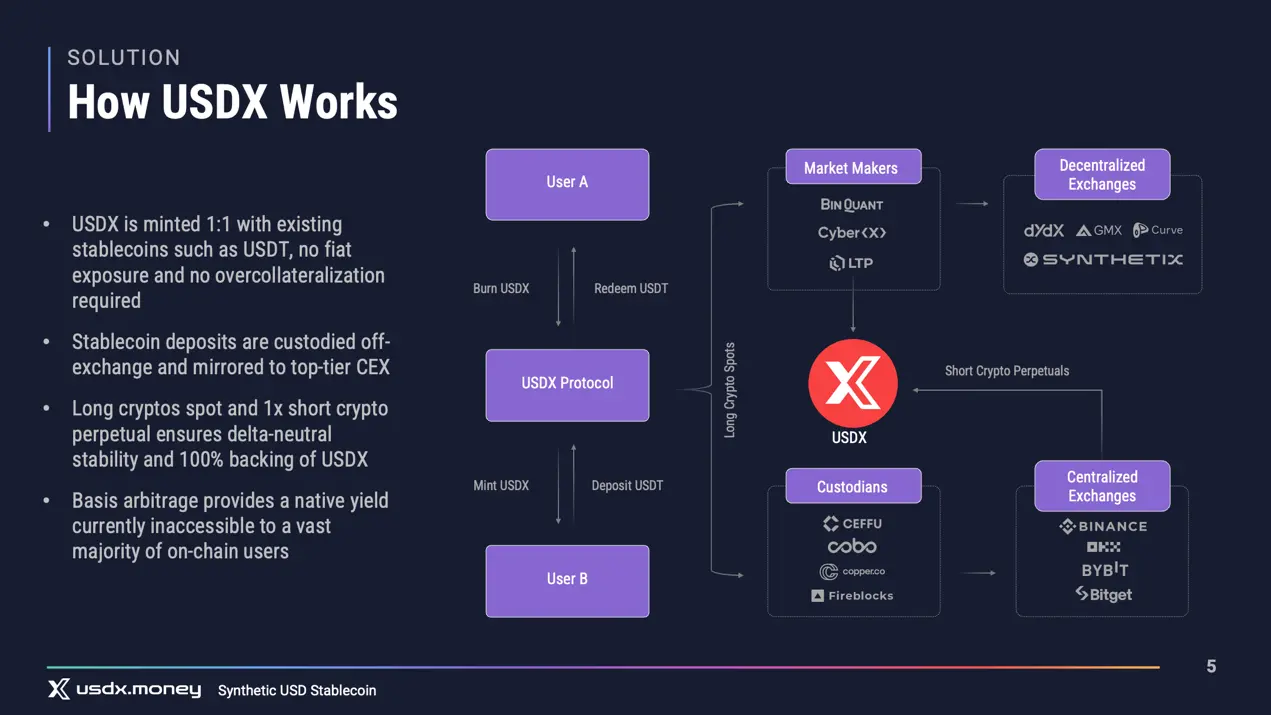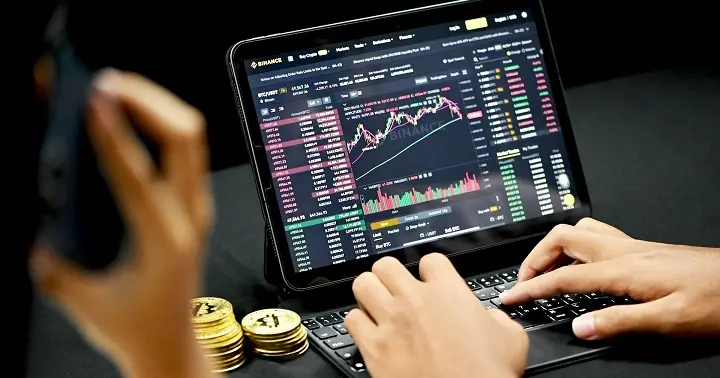Understand the emerging synthetic dollar stablecoin USDX in one article, with TVL exceeding 180 million USD, supporting multi-currency minting Delta neutral market-making strategy protocol
Author: USDX
Introduction
With the overall market recovery of the cryptocurrency market in 2024, the narratives of different sectors have also changed compared to the diverse cryptocurrency asset explosion promoted during the last bull market.
The changes in the market are quite evident, no longer solely focusing on various conceptual return expectations. Cryptocurrency users are increasingly concerned about real-time returns, and the narratives in many fields are quietly changing. Many new participants have emerged in the yield space based on mainstream cryptocurrency assets, such as USDe, Bouncebit, Solv, and USDX mentioned in this article.
For a long time, the stablecoin ecosystem in the cryptocurrency market has been one of the focal points of attention from both the industry and the market itself. Among the top ten cryptocurrencies by market capitalization, USDT and USDC have grown into widely recognized universal stablecoins, with their market capitalization continuously increasing over the past two years.
Participating in cryptocurrency market investments has always been accompanied by various risk issues. The mature stablecoin sector has been an effective way for users to avoid investment risks, while stablecoins themselves are also one of the most effective circulating certificates in today's market. Various reasons have provided a huge market liquidity for the stablecoin sector.
Correspondingly, the derivatives market based on stablecoins has become one of the popular sectors today. Currently, the Delta-neutral positions amounting to $40 billion are mainly concentrated in BTC contracts. However, BTC is limited by its own network constraints and the supporting infrastructure is not perfect. Other mainstream networks also show a similar state in this regard, meaning they cannot provide corresponding strategic returns for investors while truly avoiding price fluctuations. This provides certain participation opportunities for stablecoins based on Delta-neutral positions.
There are already many entrants in the market, and the recently emerging distributed synthetic stablecoin project usdx.money has attracted some attention.
It is reported that USDX is a new type of synthetic stablecoin that hedges the exposure of various collateral held by the protocol, anchors the value of the dollar, and captures funding rate returns. The total TVL of the project has exceeded $180 million.
This article will interpret and introduce the relevant characteristics of USDX, which at first glance appears to be a distinctly different emerging stablecoin project, possessing the viral spread potential similar to MEME coins. The project has completed its pre-launch goals and has opened the DApp and leaderboard entrance to users, with more market dynamics expected in the future.

What is USDX?
USDX is an emerging synthetic dollar stablecoin protocol that adopts a multi-chain and multi-asset strategy, which allows the protocol to achieve higher overall returns compared to products in neighboring sectors. Unlike various re-staking, LSD, and other yield methods or products, USDX has chosen a path where users can earn returns by holding stablecoins. The risk curve associated with its protocol also differs from existing products in the market, thus avoiding the relatively crowded mainstream asset yield strategies.
USDX provides a crypto-native stablecoin solution that does not rely on traditional banking infrastructure, featuring censorship resistance, scalability, and high stability. Compared to existing single mainstream dollar stablecoin projects based on BTC and others, USDX aligns more closely with the new concept of crypto savings, offering a savings tool based on multiple currencies that is globally available.
Currently, USDX has provided a complete minting and redemption mechanism, supporting interactions with various stablecoins, and will gradually integrate other mainstream cryptocurrency assets in the future, supporting over-collateralized minting methods.

USDX maintains its peg to the dollar through a Delta hedging strategy involving derivative positions, offsetting the risk of value fluctuations in the collateral held by the protocol, thereby achieving the stability of USDX's value while providing valuation returns to USDX holders or ecosystem participants.
USDX Stability Mechanism
USDX implements an automatic Delta-neutral hedging strategy for target assets to achieve value stability under all market conditions, thereby offsetting the risks brought by price fluctuations to ensure the stability of USDX's value.
"Delta" refers to the sensitivity of the derivative's value to price fluctuations of its underlying asset, which is an important parameter for maintaining the stability of USDX's value. Delta-neutral hedging is a strategy that balances potential price change risks by establishing opposing investment positions, thus avoiding the impact of market volatility on the value of the investment portfolio.
In the context of USDX, this means that if the price of the collateral asset changes, the program will automatically adjust the hedging positions to maintain the stable value of USDX.
This strategy aims to ensure that regardless of how market conditions change, the value of USDX remains relatively stable, providing cryptocurrency users with a high-quality investment risk avoidance strategy while further unlocking the enormous potential liquidity of BTC and other cryptocurrency assets.

Delta Neutrality and Market Making Strategy
The Delta involved in USDX indicates the sensitivity of the derivative's value to price changes of its underlying asset. When Delta equals zero, the investment portfolio is referred to as "Delta neutral," indicating that it is insensitive to changes in the underlying asset's price, which is also the baseline condition for USDX to maintain value stability.
Taking BTC as an example, USDX generates positive Delta due to the underlying BTC assets, and the protocol hedges by shorting perpetual contracts of BTC, thus keeping the protocol's Delta neutral.
In other words, the Delta-neutral strategy ensures that the dollar value of the protocol's asset portfolio is not affected by market price fluctuations, thereby keeping the value of USDX relatively stable, changing only when there is a brief discrepancy between spot prices and the derivatives market. Of course, the gains from rising cryptocurrency prices will also be offset by losses from matched short perpetual positions, ensuring the stability of USDX.
usdx.money conducts trading across various exchanges through market-making activities without using leverage, maintaining Delta neutrality by ensuring that the short positions in perpetual contracts match the scale of the underlying assets.
Maintaining Delta neutrality is essentially the market-making strategy employed by usdx.money. In essence, the protocol operates in this way to generate long-term returns.

It is worth mentioning that maintaining Delta-neutral positions is a common strategy used by institutional market makers to avoid risks related to price fluctuations. This practice has become very mature in both traditional finance and the cryptocurrency market.
For more official information:++usdx++ ++.money DOCs++
Protocol Arbitrage Mechanism
Since USDX needs to be minted using cryptocurrency assets, short-term market fluctuations can affect the prices of the corresponding tokens, thus providing users with certain arbitrage opportunities.
Whenever the price of USDX deviates from its peg of $1, users can utilize the protocol's minting and redemption contracts to buy or sell USDX for arbitrage.
The protocol allows certified users/whitelisted users to mint or redeem, thus gaining profits during short-term price fluctuations of USDX. For example, when the price of USDX in the external market is below $1 (e.g., 0.995), users can use 0.995 USDT to purchase 1 USDX and then redeem 1 USDT through the protocol, making a profit of 0.5%.
Conversely, if the price of USDX in the external market is above $1, users can interact with the protocol to deposit USDT to mint USDX, and then sell the newly minted USDX at a price above $1 for profit.
Due to the differences between the minting and redemption of the USDX protocol and its trading price in the external market, this provides users with long-term arbitrage opportunities.
Yield Token sUSDX
USDX holders can stake USDX to obtain sUSDX, thereby earning returns. This is a native application provided by the USDX protocol in its early stages, adopting the ERC4626 Token Vault standard, which has strong scalability.
The staking rewards depend on the funds obtained from Delta hedging derivative positions and basis returns, including subsequent staking incremental returns. Since the funds and basis returns from Delta hedging derivatives can fluctuate at any time, users' staking returns are variable.
When there are no protocol earnings transferred to the staking contract, the usdx.money insurance fund will ensure that the underlying protocol collateral is unaffected, ensuring the safety of users' USDX principal assets.
Upon unstaking, users will receive the staked USDX principal along with their proportional share of the earnings accrued in the protocol at the time of unstaking.
Essentially, sUSDX does not belong to the category of governance tokens; it serves more as a functional token to ensure that users' profit-sharing rights are guaranteed within the protocol.
Characteristics Summary
Overall, the USDX protocol has the following characteristics:
- Permissionless access, purchasable through other stablecoins on AMM platforms.
- Stable token staking returns, where the USDX used for staking will not be used for other purposes. The protocol adopts a token insurance vault strategy, similar to Binance's strategy for WBETH.
- Minting and redemption at any time, USDX can be minted simply by depositing cryptocurrency assets allowed by the protocol, and redemption can be done at any time.
- Clear arbitrage mechanism, the protocol has currently integrated with multiple AMM platforms, allowing arbitrage through minting and redemption mechanisms during market fluctuations.
- Delta-neutral market-making strategy, ensuring that the protocol generates long-term returns and maintains USDX value stability, safeguarding the health of the protocol.
- Safe and easily scalable staking contracts, adopting the ERC4626 Token Vault standard, facilitating the deployment of more use cases in the future while ensuring the safety of collateral assets.
Of course, in terms of the protocol's security, USDX has also implemented a series of measures to ensure the integrity and scalability of deployed contracts. These measures are primarily aimed at ensuring the safety of user assets while achieving reasonable governance effects and maintaining the overall health of the protocol.
Future Plans for the Protocol
Currently, USDX has been deployed on Ethereum, Arbitrum, and BNB Chain, and will integrate with multiple external markets in the future, including centralized and decentralized spot markets, such as USDX/USDC, as well as mainstream AMM platforms like Uniswap or Curve.
In the future, the protocol will integrate more use cases and different network ecosystems. The ultimate goal of the synthetic dollar stablecoin USDX, based on various cryptocurrency assets, is to become one of the mainstream universal stablecoin protocols in the cryptocurrency market.
The protocol has currently opened a points invitation system as a source for whitelisted users. USDX is currently in its early stages, and non-whitelisted users cannot directly purchase USDX, so it is advisable to keep an eye on its future developments.

Conclusion
Looking at the current development of different sectors in the cryptocurrency market, it is evident that stablecoins will continue to play a more important infrastructural role in these areas. The demand for multi-currency synthetic stablecoins will also become a very important part of various ecological infrastructure, which is the niche market demand that USDX aims to address.
However, unlike other dollar stablecoin protocols based on a single mainstream cryptocurrency asset, USDX's attempts and models regarding multi-currency are unprecedented. Additionally, the overall visual style leans towards MEME, which may bring more changes to the market.
Compared to other stablecoin protocols that adopt over-collateralization, LSD, and other models, USDX places greater emphasis on the safety of users' assets. Whether in terms of preset risk responses or the design of the yield model, it is relatively more conservative. This is a result of the Delta-neutral market-making strategy adopted by the protocol. Undoubtedly, this design is more user-friendly and secure.
If USDX and sUSDX can gain more use case support and risk investment scenarios in the future, the relatively prudent stablecoin solution promoted by the protocol will undoubtedly have greater development prospects.
After all, the upcoming BTCFi clearly indicates a strong universal demand for stablecoins like USDX.
Visit to learn more:









